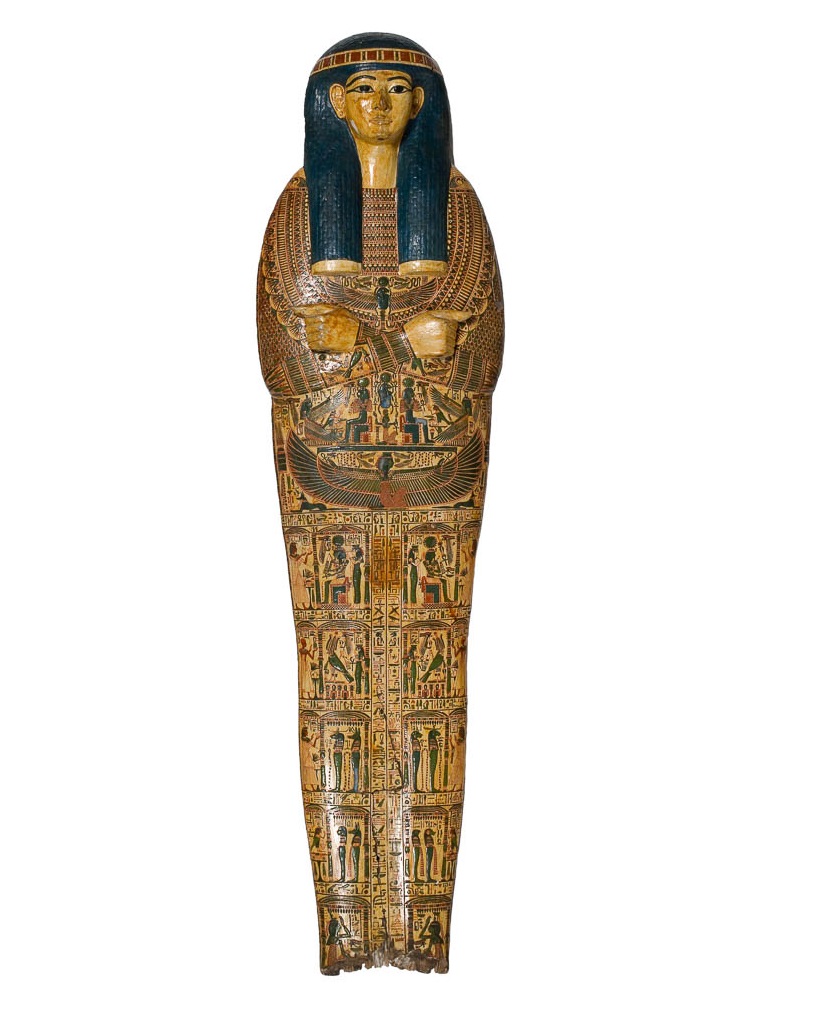Look and Think activities should take 5 -10 minutes.
Do activities might take longer depending on the task and how creative you are feeling!
The mummy board from the coffin set of Nespawershefyt, unknown maker, about 1000 BC
Outer coffin length approx 205 cm, E.1.1822
Look
This coffin is covered in wonderful pictures of ancient Egyptian gods. Watch this story of the sun boat (called a solar barque). Did you spot the boat? Who is standing in it? Look closely here.
Think
Nespawershefyt lived in Thebes, modern day Luxor, between 990 – 940 B.C. Can you work out how many years ago that was?
How do you think these wooden coffins survived for so many years without rotting?
Do
Recent research into these coffins has helped us to work out what tools the ancient Egyptians may have used. Make your own ancient Egyptian paintbrush with our short ‘how to’ video.

How has Nespawershefyt’s wooden coffin survived for over 3000 years without rotting ?
Helen Strudwick, Curator of Ancient Egyptian collections, explains:
‘Objects made of materials that would decay if you left them in the ground in the UK, such as wooden objects, do not usually rot in Egypt. This is because the rotting process is a result of the actions of bacteria or fungi, and those need moisture to survive. The Egyptian climate is very dry, because Egypt has very little rainfall and lies at the very edge of the Sahara, one of the driest places on earth. Without the moisture, those bacteria or fungi are just not very active and so wooden objects are often amazingly well-preserved considering their age. This means that we have to be very careful about keeping them in a suitably dry environment here in the UK.’
You will need
Some string
Scissors
Paint
1. Wrap the string around your hand until your fingers are covered half way up.
2. Carefully take the string off your fingers
3. Tie around the string bundle leaving a centimetre from the top
4. Wrap the string round and round the bundle and tie it tightly at the end, cutting off the end.
5. Cut the ends of your brush where you left a centimetre.
6. Now you can start painting!
The Solar Barque was used by the sun god Ra in ancient Egyptian mythology.
This detail is from the wooden anthropoid (human shaped) coffin set of Nespawershefyt. It is comprised of a mummy board and an inner coffin and an outer coffin. These both had a separate lid and box that would have all fitted together, one inside another. This was the first object acquired into The Fitzwilliam Museum’s ancient Egyptian collections. It was donated by two graduates of the University of Cambridge in 1822. Although we know they collected it whilst travelling, we do not know how they acquired the coffin set.
We know from the hieroglyphic inscriptions on this coffin set that Nespawershefyt was a high ranking official who worked at the temple of Karnak in ancient Thebes. His principal roles were ‘supervisor of craftsmen’s workshops’ in Karnak, and ‘supervisor of scribes’ in the temple of Amun. It is not surprising that someone high ranking within an arts and crafts profession has such a highly decorated coffin set. Presumably he could choose the best craftsmen for the job, and have a say over what would be included. The coffin set is densely decorated with religious scenes, including magical spells from the Book of the Dead. The text describes the types of offerings Nespawershefyt would receive in the afterlife, and spells to assure his safe passage to the netherworld. This panel shows Nespawershefyt kneeling down and offering his heart to be weighed by Anubis, the jackal headed god of mummification.
Since 2014, The Fitzwilliam Museum has been conducting cutting-edge interdisciplinary research into its collection of more than 200 ancient Egyptian coffins and coffin fragments. You can find out more about Nespawershefyt’s coffin set on the Ancient Egyptian Coffins Project website.
Download this Look Think Do as a PDF or a Word document.